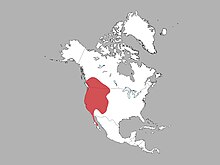Northern long-eared mouse-eared mouse
| Northern long-eared mouse-eared mouse | ||||||||||||
|---|---|---|---|---|---|---|---|---|---|---|---|---|

Northern long-eared mouse-eared mouse ( Myotis evotis ) |
||||||||||||
| Systematics | ||||||||||||
|
||||||||||||
| Scientific name | ||||||||||||
| Myotis evotis | ||||||||||||
| ( H. Allen , 1864) |
The northern long-eared mouse-eared mouse ( Myotis evotis ) is a bat in the smooth-nosed family that is found in western North America.
features
With a forearm length that does not reach 40 mm, the species is smaller than the similar North American fringed bat ( Myotis thysanodes ). Furthermore, it lacks the fringes typical of the other species on the edges of the tail skin. However, there may be individual hairs on the edges. Both bats have long ears and a calcar without a notch on their feet. The hair is black in the area of the hair root and brownish towards the tips, which creates a shiny light brown to golden brown appearance on the top, while the underside is even lighter to whitish.
The ears are slightly longer than 21 mm, the wingspan is 250 to 300 mm and the weight is 5 to 8 g.
distribution
The distribution area extends from the Canadian areas of British Columbia , Alberta and Saskatchewan to the Mexican state of Baja California Sur . In the USA the species occurs from the Pacific to North Dakota , Colorado and New Mexico . The northern long-eared mouse-eared ear reaches a height of 2830 meters in the mountains. The habitat mostly consists of coniferous forests, mountain forests and humid landscapes near the sea. The species can adapt to different biotopes.
Way of life
In the northwestern area of the distribution area, the northern long-eared mouse-eared mouse mostly rests in tree hollows of dead trees or under tree stumps. Here specimens of the yellow pine or the coastal pine are preferred. Further to the east, the sleeping places are often in crevices of sandstone rocks. Buildings, earth caves, abandoned mine tunnels, larger caves or loose parts of the tree bark are also used as hiding places.
Moths and other insects such as beetles , grasshoppers and flies are usually hunted through clearings or other areas with flat vegetation. Occasionally spiders are caught. The northern long-eared mouse-eared mouse flies slowly and in a straight line and collects prey from green plants, fallen trees, rocks or from the ground.
Pregnant females were usually registered in early summer (May - June) and the litter consists of a single young. Since most males had thickened testicles in July and August, it is believed that mating occurs shortly thereafter and the sperm are stored in the female reproductive tract until the onset of pregnancy in spring. Newborn northern long-eared mouse-ears weigh a little over a gram and are bare, while the tips of individual teeth are already visible. Their body length is 40 to 47 mm.
In caves, pregnant females form colonies of 12 to 30 specimens separated from other females and males. Individuals have been documented that left their hiding place shortly after sunset, while other specimens began their hunt in complete darkness.
Danger
Disturbances in caves and mines as well as deforestation can have a negative impact on the population. There are several nature reserves in the distribution area. The IUCN lists the northern long-eared mouse-eared mouse as Least Concern .
Individual evidence
- ↑ Don E. Wilson , DeeAnn M. Reeder (Ed.): Mammal Species of the World . A taxonomic and geographic Reference . 3. Edition. 2 volumes. Johns Hopkins University Press, Baltimore MD 2005, ISBN 0-8018-8221-4 (English, Myotis evotis ).
- ↑ a b c d B. J. Verts & Leslie N. Carraway: Land Mammals of Oregon . University of California Press, 1998, pp. 84-87 ( Myotis evotis ).
- ↑ Long-eared Myotis - Myotis evotis . Montana Field Guide. Montana Natural Heritage Program and Montana Fish, Wildlife and Parks. Visited December 28, 2019.
- ↑ a b c Myotis evotis in the endangered Red List species the IUCN 2017. Posted by: Arroyo-Cabrales, J. & Álvarez-Castañeda, ST, 2016. Retrieved on December 28 of 2019.
